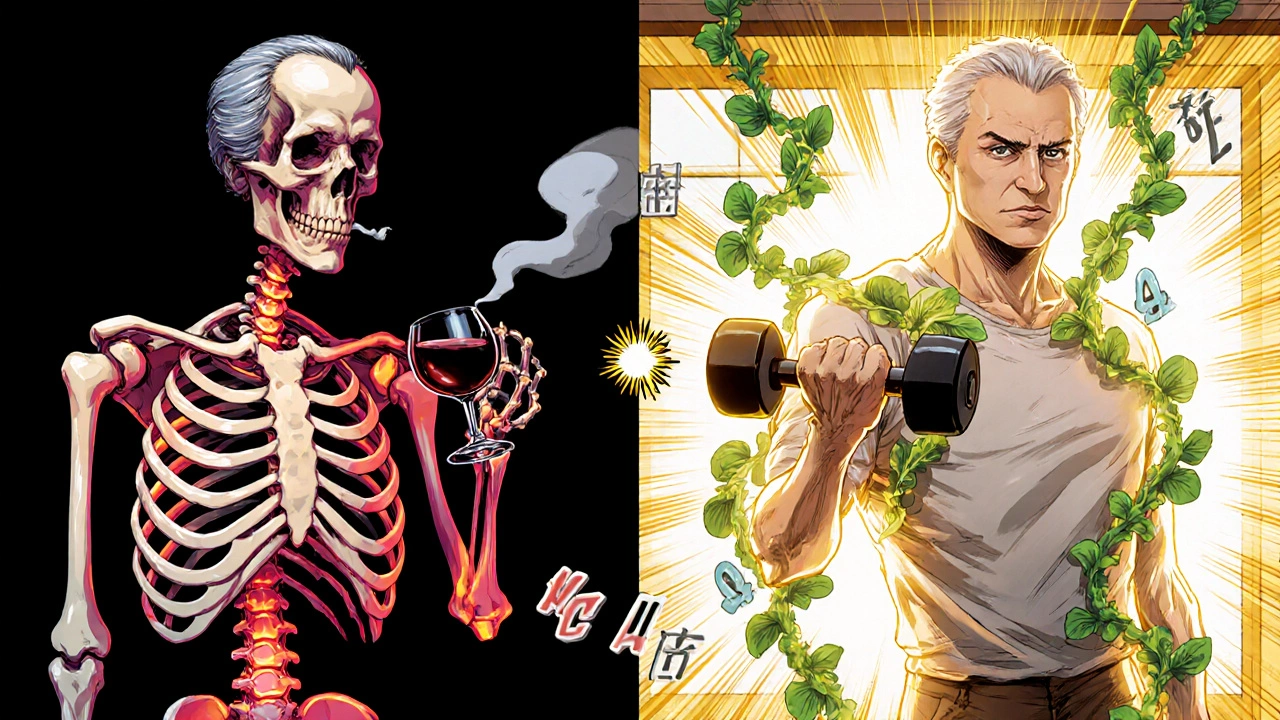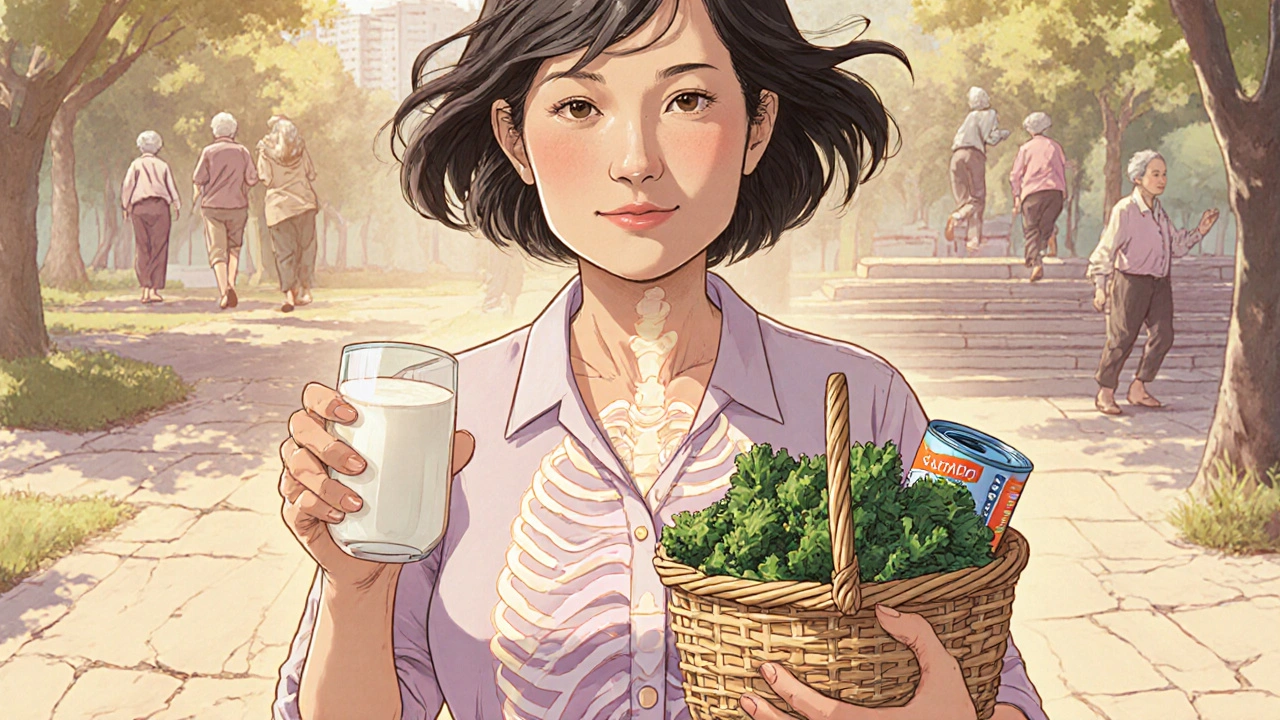One in three women over 50 will break a bone because of weak bones. One in five men over 50 will too. And most of them had no idea their bones were crumbling until it was too late. Osteoporosis doesn’t come with pain, swelling, or warning signs. It sneaks in silently, stealing strength from your skeleton until a simple stumble turns into a broken hip, a crushed spine, or worse. The good news? You can stop it - if you know what to do.
Why Your Bones Are Losing Strength
Your bones aren’t static. They’re alive, constantly breaking down and rebuilding. Until about age 30, your body builds more bone than it loses. That’s your peak bone mass. After that, the balance shifts. You lose a little each year - about 0.3% to 0.5%. But for women after menopause, that rate jumps to 2% to 3% a year for the first five to seven years. That’s not just aging. That’s a biological earthquake. Men lose bone too, but slower. Why? Women start with less bone mass to begin with, and when estrogen drops, the body’s bone-building system slows down fast. Men with low testosterone face similar risks. Age isn’t the only culprit. Genetics play a huge role. If your mom or dad broke a hip after 50, your risk goes up by 60% to 80%. White and Asian women are at higher risk than Black or Hispanic women. And if you had early menopause - before 45 - your odds of fracture jump 2.1 times.The Hidden Triggers You Can Control
Not everything about osteoporosis is written in your DNA. Many of the biggest risks are habits you can change. And fixing them doesn’t require magic pills or expensive treatments. Calcium isn’t optional. Adults under 50 need 1,000 mg a day. After 50, you need 1,200 mg. But most people get less than half that. Dairy isn’t the only source. Canned salmon with bones, kale, bok choy, fortified plant milks, and tofu set in calcium sulfate all count. If you can’t get enough from food, supplements help - but don’t take more than 500-600 mg at once. Your body can’t absorb more. Spread it out with meals. Vitamin D is the key that unlocks calcium. Without it, your body can’t use the calcium you eat. Over 40% of U.S. adults are deficient. You need 800-1,000 IU daily. If your levels are below 20 ng/mL, you may need 2,000 IU for a few months to catch up. Sunlight helps, but in winter or if you’re indoors most of the day, supplements are your best bet. Smoking cuts your bone density by 55%. It messes with estrogen, blocks calcium absorption, and kills bone-building cells. Quitting doesn’t reverse all the damage, but it stops the bleeding. Every year you stay smoke-free, your bones get a little stronger. Alcohol is a bone killer. More than two drinks a day increases hip fracture risk by 41%. That’s not just heavy drinking - it’s two glasses of wine or two beers daily. Cut back. Even one drink a day is safer than two. Sitting is the silent thief. If you don’t put stress on your bones, they forget how to stay strong. Sedentary people have 25% to 30% higher fracture risk. The fix? Weight-bearing exercise. Walking, dancing, stair climbing, hiking - anything where your feet hit the ground and your muscles pull on your bones. Do it 30 to 45 minutes, five days a week. Add resistance training twice a week - squats, lunges, dumbbell lifts. You’ll start seeing bone density improvements in 6 to 12 months.Fractures Don’t Come Out of Nowhere
A broken bone from a fall from standing height or less? That’s not an accident. That’s a red flag. If you’ve already had one fracture, your chance of another goes up by 86% for a spine fracture and 200% for a hip. And here’s the shocking part: bone density scans don’t catch half the people who will break a bone. That’s why doctors now use tools like FRAX. It doesn’t just look at your DEXA scan. It asks: Are you over 65? Did you smoke? Do you drink too much? Have you had a previous fracture? Is your parent had a hip fracture? It weighs all of it - and gives you a 10-year fracture risk percentage. If it’s over 20%, treatment is usually recommended, even if your bone density is only in the osteopenia range.
What Happens After a Fracture?
A hip fracture isn’t just a broken bone. It’s a life-altering event. One in five people die within a year. Many never walk again. Others end up in long-term care. The cost? Over $57 billion a year in the U.S. alone. And it’s rising. But here’s the flip side: prevention works. Every dollar spent on preventing fractures saves $5.40 in future care costs. That’s why fall prevention is just as important as bone strengthening. Simple changes cut fracture risk by nearly 30%:- Remove loose rugs and cords from floors
- Install grab bars in the bathroom
- Use non-slip mats in the shower
- Improve lighting, especially on stairs
- Get your vision checked yearly
- Review medications with your doctor - some cause dizziness
When Medication Makes Sense
Not everyone needs drugs. But if you’re over 65, have had a fracture, or have a high FRAX score, medication can be life-saving. Bisphosphonates (like alendronate or risedronate) are the most common. They slow bone loss. But they can cause stomach upset or jaw problems in rare cases. Some people stop taking them because of side effects - and that’s dangerous. If you can’t tolerate them, talk to your doctor. Alternatives like denosumab or romosozumab (Evenity) work differently. Romosozumab actually builds new bone while slowing breakdown - and cuts spine fractures by 73% in a year. Don’t wait for a fracture to start thinking about treatment. If your doctor says you’re at high risk, don’t brush it off. Bone loss is silent. Fractures are loud.The Real Game-Changer: Start Early
The best time to build strong bones? When you’re 10, 15, or 20. Peak bone mass by age 30 determines 60% to 80% of your lifelong fracture risk. Kids who get enough calcium, vitamin D, and exercise are less likely to break bones as adults. But it’s never too late. Even if you’re 70, adding weight-bearing exercise and supplements can still improve bone density. One small study found a specific probiotic, Lactobacillus reuteri, boosted bone density by 1.5% to 2% in 12 months - not a miracle, but a meaningful step.

